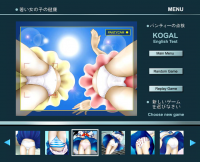Visual Novel

Contents |
General history
Dating sims first began to appear the early Eighties. One of the first games to hit the Japanese market was Night Life by Koei (1982). These primitive visual novels were none too popular, being limited to 16 color graphics. At the inception of the genre, almost all the games were pornographic.
A notable landmark was Jast's Tenshitachi no gogo (1985), a precursor to modern dating simulation. Among early VNs, it had a degree of polish absent from previous games. It was also the first to have recognizably modern anime-style artwork: its characters had large eyes and a tiny nose and mouth but were otherwise normally proportioned, characteristics which tare now found in virtually all forms of Japanese animated media.
By the beginning of the 1990s, the industry had moved away from proprietary Japanese hardware to the burgeoning DOS platform, and then later in the decade to Windows. From that point on, dating sims (and computer games in general) underwent a technological revolution as the market expanded beyond East Asia. With the advent of the world wide web, Japanese popular culture gained widespread popularity in Europe and America, spurred on to some degree by the rise of the so-called "otaku" community.
Despite massive advances in rendering technology, the VN industry has mostly resisted the transition into 3D graphics due to the blocky and distorted nature when viewed in extreme close up. 2001's Tokimeki Memorial 3 was one of the first games to break this trend; however, low sales and consumer disinterest ensured that traditional 2D graphics continued to dominate the market. This stalemate may eventually be resolved when the two formats become more compatible.
Game engines
Throughout the early 2000s, Adobe Flash was the most common gaming platform within the online community (see Flash Games). After the software was superseded by HTML5, Flash began to fall out of favor with game makers and enthusiasts. One of the more popular game engines to emerge in recent years is Ren'Py (レンパイ). Originating in Japan during the late 1990s, Ren'Py includes the ability to create branching stories, complete with scene transitions, full-screen movies and animated sprites. Designed specifically for visual narratives and graphic storytelling, the format allows the player to interact with various characters from either first-person or third-person perspectives. This versatility of gameplay has contributed to its overwhelming popularity in Japan and its increasingly high profile in the West.